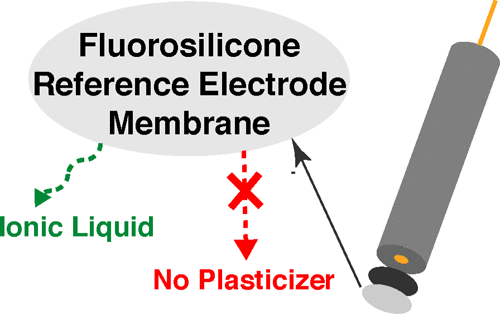Our official English website, www.x-mol.net, welcomes your
feedback! (Note: you will need to create a separate account there.)
Reference Electrodes Based on Ionic Liquid-Doped Reference Membranes with Biocompatible Silicone Matrixes.
ACS Sensors ( IF 8.2 ) Pub Date : 2020-05-05 , DOI: 10.1021/acssensors.0c00363 Xin V Chen 1 , Andreas Stein 1 , Philippe Bühlmann 1
ACS Sensors ( IF 8.2 ) Pub Date : 2020-05-05 , DOI: 10.1021/acssensors.0c00363 Xin V Chen 1 , Andreas Stein 1 , Philippe Bühlmann 1
Affiliation

|
Many reference electrodes with an ionic liquid-doped reference membrane contain a plasticizer that can gradually leach out into the sample. However, because many common plasticizers are known to be endocrine disruptors and may induce inflammatory reactions, they are preferably avoided for wearable or implantable sensors. Therefore, this work tested polymeric reference electrode membranes prepared by solvent casting from seven commercially available biocompatible silicones that are widely used in implantable devices. Only reference electrodes with membranes consisting of poly(3,3,3-trifluoropropylmethylsiloxane) (Fluorosilicone 1) and one of several 1-methyl-3-alkylimidazolium bis(trifluoromethylsulfonyl)imide ionic liquids provided a stable and sample-independent potential in electrolyte solutions spanning the range of electrolyte concentrations in human blood, with more hydrophobic ionic liquids performing better. Over 8 days at 37 °C in artificial blood electrolyte solutions, the reference membranes doped with 1-methyl-3-octylimidazolium bis(trifluoromethylsulfonyl)imide exhibited a potential drift as low as 20 μV/h. In 10% animal serum, a 112 μV/h drift was observed over 5.8 days. The other six silicone materials doped with an ionic liquid either failed to form self-standing membranes or did not provide a sample-independent potential in the ionic concentration range tested. In case of the functional reference electrodes, differential scanning calorimetry confirmed good miscibility between the ionic liquid and the polymer matrix, whereas the poor miscibility of four polymer matrixes and the ionic liquids—as confirmed by differential scanning calorimetry—correlated with an undesirable sample dependence of the reference potential.
中文翻译:

基于离子液体掺杂参比膜和生物相容性有机硅基质的参比电极。
许多带有离子液体掺杂参比膜的参比电极都包含可逐渐浸出到样品中的增塑剂。但是,由于已知许多常见的增塑剂是内分泌干扰物,并可能引起炎症反应,因此,对于可穿戴或可植入的传感器,最好避免使用它们。因此,这项工作测试了聚合物参比电极膜,该聚合物参比电极膜是由溶剂浇铸而成的,该膜由广泛用于可植入设备的七种市售生物相容性有机硅制成。仅参比电极,其膜由聚(3,3,3-三氟丙基甲基硅氧烷)构成(氟硅氧烷1)和几种1-甲基-3-烷基咪唑双(三氟甲基磺酰基)酰亚胺离子液体中的一种在电解质溶液中提供了稳定且不依赖样品的电势,横跨人类血液中电解质的浓度范围,疏水性离子液体的性能更好。在人造血液电解质溶液中,在37°C下经过8天,掺有1-甲基-3-辛基咪唑双(三氟甲基磺酰基)酰亚胺的参比膜表现出低至20μV/ h的电位漂移。在10%的动物血清中,在5.8天内观察到112μV/ h的漂移。掺杂有离子液体的其他六种有机硅材料要么无法形成自立膜,要么无法在测试的离子浓度范围内提供不依赖样品的电势。对于功能参比电极,
更新日期:2020-06-26
中文翻译:

基于离子液体掺杂参比膜和生物相容性有机硅基质的参比电极。
许多带有离子液体掺杂参比膜的参比电极都包含可逐渐浸出到样品中的增塑剂。但是,由于已知许多常见的增塑剂是内分泌干扰物,并可能引起炎症反应,因此,对于可穿戴或可植入的传感器,最好避免使用它们。因此,这项工作测试了聚合物参比电极膜,该聚合物参比电极膜是由溶剂浇铸而成的,该膜由广泛用于可植入设备的七种市售生物相容性有机硅制成。仅参比电极,其膜由聚(3,3,3-三氟丙基甲基硅氧烷)构成(氟硅氧烷1)和几种1-甲基-3-烷基咪唑双(三氟甲基磺酰基)酰亚胺离子液体中的一种在电解质溶液中提供了稳定且不依赖样品的电势,横跨人类血液中电解质的浓度范围,疏水性离子液体的性能更好。在人造血液电解质溶液中,在37°C下经过8天,掺有1-甲基-3-辛基咪唑双(三氟甲基磺酰基)酰亚胺的参比膜表现出低至20μV/ h的电位漂移。在10%的动物血清中,在5.8天内观察到112μV/ h的漂移。掺杂有离子液体的其他六种有机硅材料要么无法形成自立膜,要么无法在测试的离子浓度范围内提供不依赖样品的电势。对于功能参比电极,











































 京公网安备 11010802027423号
京公网安备 11010802027423号